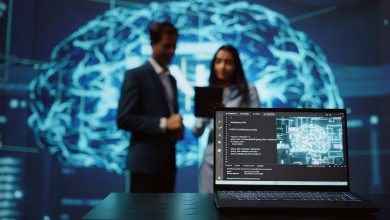
For years, the enterprise AI conversation has centered around augmentation: AI as a tool, a copilot, a helpful assistant to make humans more effective. This framing was helpful during early adoption. It positioned AI as a safe extension of existing roles—augmenting, not replacing—and helped enterprises experiment without disrupting core operations. But that framing no longer captures the full picture.
AI is now moving into execution. Autonomous agents are being deployed to complete tasks that were once exclusively human. These agents can manage structured processes from end to end, take action inside core systems, and handle exceptions using encoded business logic. They’re not just suggesting what to do next—they’re doing it, consistently and at scale.
And while the technology is evolving quickly, the implications for how businesses operate are already playing out in production environments.
What Makes an AI Agent?
The distinction between assistants and agents lies in accountability. Assistants support users by retrieving data or generating suggestions, but rely on human judgment for execution. Agents are built to act independently. Within defined parameters, they make decisions, initiate workflows, and interact directly with business systems.
Unlike traditional automation, agents adapt to context. They pursue goals, respond to real-time inputs, and operate as embedded decision-makers within the enterprise. Their autonomy is bounded by organizational rules, with infrastructure ensuring their actions remain aligned with business objectives and regulatory standards.
Operational Foundations and Controls
Deploying AI agents is not primarily a modeling challenge—it’s an infrastructure challenge. For agents to function responsibly and effectively, three conditions must be met: access to reliable data, access to formalized logic, and the ability to execute.
First, agents require a unified, real-time view of the operational environment, with access to accurate datasets across systems. Second, business logic must be codified and machine-readable—not just high-level policies, but detailed process rules: the hows, whats, and whens. Third, agents must be integrated with systems of record through secure, auditable interfaces—ensuring their actions are not just theoretical, but operational.
This same infrastructure forms the foundation for effective risk management. With the right controls in place, agents don’t increase operational risk—they reduce it. Oversight must include real-time monitoring, human override capabilities, and comprehensive audit logs of all decisions and actions. In essence, any system involving agents must be explainable—not only in terms of outcomes, but in terms of process.
Case Study: Private Credit Operations, Transformed
Private credit is one of the most promising domains for AI agent deployment. This fast-growing segment of financial services now manages over $2 trillion in assets, with fund operations that are both high-stakes and highly complex.
Day-to-day activities involve thousands of tasks—booking loans, tracking payments, calculating interest, and ensuring compliance with investor agreements—all of which are still largely manual. These processes, while essential, are repetitive, time-consuming, and prone to human error. Despite absorbing significant time and cost, much of the work delivers limited strategic value. This operational burden makes private credit a prime candidate for automation—and specifically, for AI agents.
Forward-thinking firms are already deploying agents to manage many of these responsibilities autonomously. Agents can interpret deal terms and structure new financial instruments, reconcile cash flows across entities and timelines, calculate interest accruals, generate borrower notices without manual input, and proactively flag discrepancies before they escalate. The impact goes far beyond efficiency: accuracy improves, turnaround times shrink, and audit readiness becomes built-in. Most importantly, operations teams are freed to focus on higher-value work—like solving problems, managing exceptions, and building relationships.
Not Just a Financial Services Trend
While private credit is a leading use case, the shift toward agent-based execution is visible across sectors. In healthcare, agents are managing intake forms, claims processing, and patient coordination. In legal, they’re reviewing contracts, tracking obligations, and flagging inconsistencies. In supply chains, they’re optimizing inventory levels and adjusting logistics in real time. Even within IT and infrastructure, agents are autonomously provisioning systems, responding to incidents, and maintaining uptime without constant intervention.
What unites these industries is the presence of high-volume, rules-based, operational tasks that require both speed and consistency. These are precisely the conditions where AI agents thrive. And as adoption spreads, companies are learning that the opportunity isn’t just about automating individual tasks – it’s about rethinking how work gets done altogether.
Looking Ahead: The Next Horizon
The era of treating AI as a novelty is over. We now understand its potential – and its implications – with far greater clarity. So what comes next for AI agents?
We’re beginning to see the rise of multi-agent systems, where specialized agents coordinate to manage complex, interdependent tasks. Cross-domain orchestration is also emerging, with agents operating across departments to drive end-to-end processes. We’re also seeing early signs of agent-augmented decision-making—where agents don’t just execute, but advise, offering real-time insights and scenario modeling to support human judgment at scale.
As this shift accelerates, enterprise leaders must ask critical questions: How should internal controls evolve as decision-making becomes more distributed? Where does human oversight remain essential, and where can it be confidently delegated? And perhaps most importantly: what does a high-performing team look like when machines are no longer just tools—but operational collaborators?
Organizations that answer these questions with clarity and discipline—building secure, transparent foundations for agent-driven execution—won’t just move faster. They’ll define what high-performance enterprise operations look like in the years ahead.
Written by: Daniel Liechtenstein, Co-founder and CEO of Hypercore
Bio: Daniel Liechtenstein is the co-founder and CEO of Hypercore, a pioneering company that offers a data-first loan management platform for non-bank commercial lenders. Hypercore’s mission is to simplify and streamline the management of loans, funding, and client data. As a serial entrepreneur, Daniel has extensive experience leading Fintech ventures and software development projects, including core banking systems and open banking APIs. His expertise lies at the intersection of finance and technology, where he consistently drives innovation and efficiency. Daniel holds an MSc in Financial Mathematics and a BA in Economics and Business Management.






